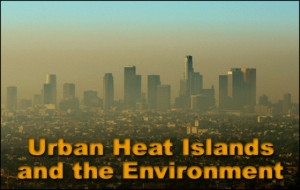The Environmental Problems Caused by Scorching Summers in the City
In addition to the health problems caused by an urban heat island (UHI), there are also serious environmental consequences.
Urban heat islands create far-reaching environmental complications that affect not only the city itself, but also surrounding weather patterns, air quality, water quality, ecosystems, and even seasons.
Environmental Impacts of Urban Heat Islands
An urban heat island significantly affects the environment around it:
- Urban building alters the landscape, displacing natural vegetation and wildlife and disrupting ecosystems.
- Escalating pollution changes the atmosphere around the heat island. Harmful toxins in the air create ground-level ozone (smog) and acid rain.
- Rising heat in the atmosphere may increase rainfall and fuel violent thunderstorms.
- Rural areas downwind of an UHI often experience greater rainfall rates than those areas upwind of the city. Areas downwind from a UHI may also experience a decrease in air quality.
- Rain falling on overheated pavement becomes superheated. According to the Environmental Protection Agency (EPA), pavement at a temperature of 100°F can raise runoff water temperatures by 25°F. As the storm water enters creeks, streams, ponds, and lakes, the water temperature rises, shocking local ecosystems and sometimes killing fish.
- Urban heat islands lengthen growing seasons, alter wind patterns, and change the surrounding climate dramatically.
- Higher temperatures in UHIs strain the energy grid, as air conditioning systems struggle to relieve the heat. Power outages and rolling blackouts are common as energy demands peak.
- Amplified energy production at power plants means increased pollution, adding to the air quality problem.
How Steel Buildings Combat Urban Heat Islands
- RHINO Steel Building Systems are environmentally friendly, green building systems.
- Pre-engineered buildings assure the strongest structure with the lease amount of materials.
- All RHINO structures contain recycled steel components.
- Heavy-duty insulation systems take advantage of the deep wall cavities of a steel building.
- Better insulation means less energy wasted and much lower utility bills.
- Options like skylights and cool-coated reflective steel paneling save even more.
- At the end of the building’s usefulness, all the framing can be recycled again, without any loss of strength.
Want to know more about the RHINO Difference?
Call 940.383.9566 to discuss details about our company, our building system, and our building accessories.
